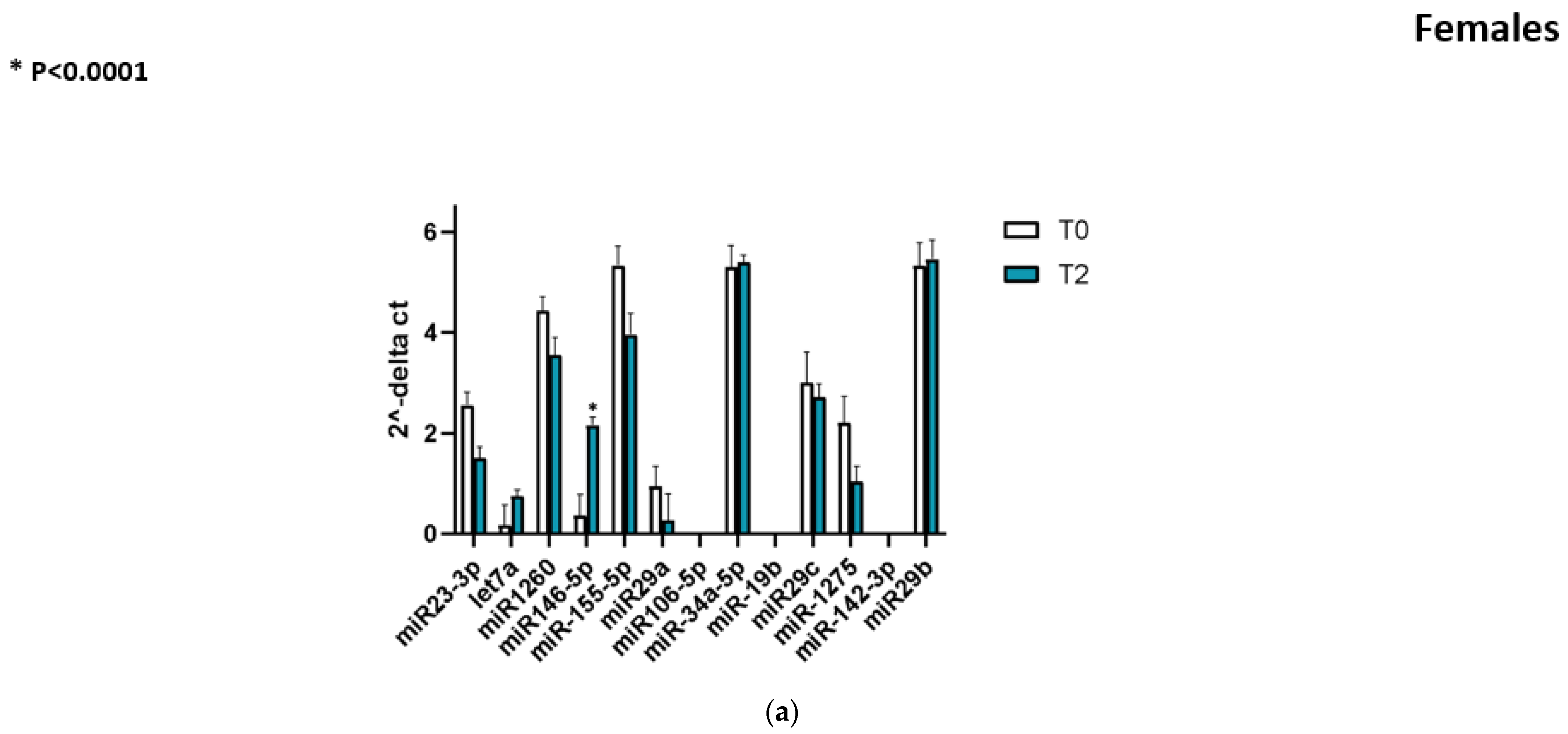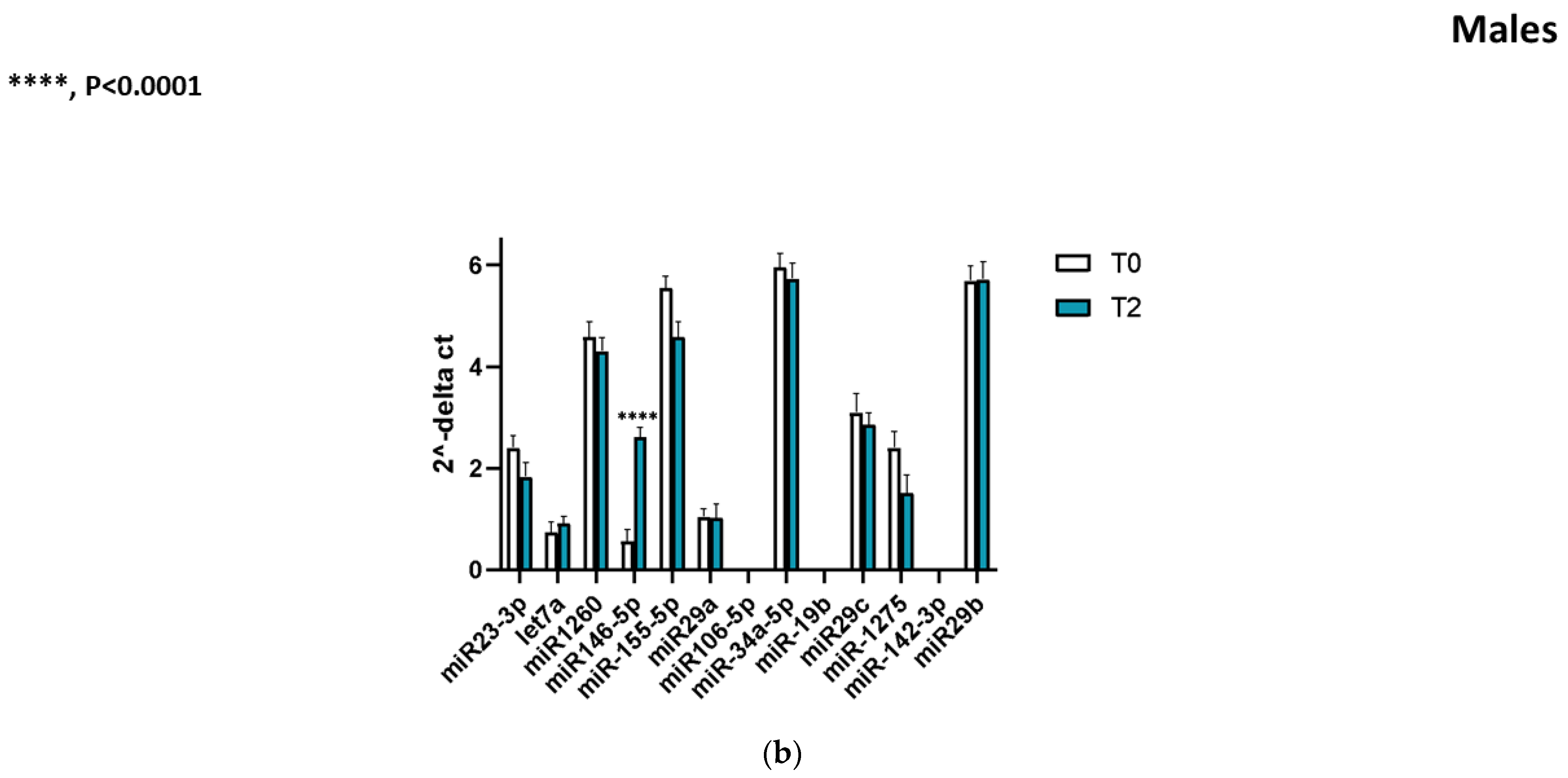Sex-Independent Upregulation of miR-146a-5p in Parkinson’s Disease Patients: A Longitudinal Study
Abstract
1. Introduction
2. Results
2.1. Participant Characteristics
2.2. Baseline miRNA Expression by Sex
2.3. Longitudinal Change in miR-146a-5p
2.4. Other miRNAs
3. Discussion
3.1. Comparison with Previous Studies
3.2. Biological Significance of miR-146a-5p Upregulation
3.3. Implications for Biomarkers and Therapy
3.4. Limitations
4. Materials and Methods
4.1. Study Participants
4.2. Sample Collection and Processin
4.3. miRNA Extraction and Quantification
4.4. Statistical Analysis
5. Conclusions
Supplementary Materials
Author Contributions
Funding
Institutional Review Board Statement
Informed Consent Statement
Data Availability Statement
Conflicts of Interest
References
- Shaheen, N.; Shaheen, A.; Osama, M.; Nashwan, A.J.; Bharmauria, V.; Flouty, O. MicroRNAs regulation in Parkinson’s disease, and their potential role as diagnostic and therapeutic targets. npj Park. Dis. 2024, 10, 186. [Google Scholar] [CrossRef]
- Mollenhauer, B. Status of Current Biofluid Biomarkers in Parkinson’s Disease. Mov. Disord. Clin. Pract. 2023, 10 (Suppl. S2), S18–S20. [Google Scholar] [CrossRef] [PubMed] [PubMed Central]
- Guévremont, D.; Roy, J.; Cutfield, N.J.; Williams, J.M. MicroRNAs in Parkinson’s disease: A systematic review and diagnostic accuracy meta-analysis. Sci. Rep. 2023, 13, 16272. [Google Scholar] [CrossRef] [PubMed] [PubMed Central]
- Zhang, W.T.; Wang, Y.J.; Yao, Y.F.; Zhang, G.X.; Zhang, Y.N.; Gao, S.S. Circulating microRNAs as potential biomarkers for the diagnosis of Parkinson’s disease: A meta-analysis. Neurol. (Engl. Ed.) 2024, 39, 573–583. [Google Scholar] [CrossRef] [PubMed]
- Caggiu, E.; Paulus, K.; Mameli, G.; Arru, G.; Sechi, G.P.; Sechi, L.A. Differential expression of miRNA 155 and miRNA 146a in Parkinson’s disease patients. eNeurologicalSci 2018, 13, 1–4. [Google Scholar] [CrossRef] [PubMed] [PubMed Central]
- Singh, A.; Sen, D. MicroRNAs in Parkinson’s disease. Exp. Brain Res. 2017, 235, 2359–2374. [Google Scholar] [CrossRef] [PubMed]
- Vallelunga, A.; Iannitti, T.; Dati, G.; Capece, S.; Maugeri, M.; Tocci, E.; Picillo, M.; Volpe, G.; Cozzolino, A.; Squillante, M.; et al. Serum miR-30c-5p is a potential biomarker for multiple system atrophy. Mol. Biol. Rep. 2019, 46, 1661–1666. [Google Scholar] [CrossRef] [PubMed]
- Vallelunga, A.; Iannitti, T.; Capece, S.; Somma, G.; Russillo, M.C.; Foubert-Samier, A.; Laurens, B.; Sibon, I.; Meissner, W.G.; Barone, P.; et al. Serum miR-96-5P and miR-339-5P Are Potential Biomarkers for Multiple System Atrophy and Parkinson’s Disease. Front. Aging Neurosci. 2021, 13, 632891. [Google Scholar] [CrossRef] [PubMed] [PubMed Central]
- Taganov, K.D.; Boldin, M.P.; Chang, K.J.; Baltimore, D. NF-kappaB-dependent induction of microRNA miR-146, an inhibitor targeted to signaling proteins of innate immune responses. Proc. Natl. Acad. Sci. USA 2006, 103, 12481–12486. [Google Scholar] [CrossRef] [PubMed] [PubMed Central]
- Yang, R.; Yang, B.; Liu, W.; Tan, C.; Chen, H.; Wang, X. Emerging role of non-coding RNAs in neuroinflammation mediated by microglia and astrocytes. J. Neuroinflamm. 2023, 20, 173. [Google Scholar] [CrossRef] [PubMed] [PubMed Central]
- Jauhari, A.; Singh, T.; Mishra, S.; Shankar, J.; Yadav, S. Coordinated Action of miR-146a and Parkin Gene Regulate Rotenone-induced Neurodegeneration. Toxicol. Sci. 2020, 176, 433–445. [Google Scholar] [CrossRef] [PubMed]
- Ardashirova, N.S.; Abramycheva, N.Y.; Fedotova, E.Y.; Illarioshkin, S.N. MicroRNA Expression Profile Changes in the Leukocytes of Parkinson’s Disease Patients. Acta Naturae 2022, 14, 79–84. [Google Scholar] [CrossRef] [PubMed] [PubMed Central]
- Vallelunga, A.; Iannitti, T.; Somma, G.; Russillo, M.C.; Picillo, M.; De Micco, R.; Vacca, L.; Cilia, R.; Cicero, C.E.; Zangaglia, R.; et al. Gender differences in microRNA expression in levodopa-naive PD patients. J. Neurol. 2023, 270, 3574–3582. [Google Scholar] [CrossRef] [PubMed] [PubMed Central]
- Lei, B.; Liu, J.; Yao, Z.; Xiao, Y.; Zhang, X.; Zhang, Y.; Xu, J. NF-κB-Induced Upregulation of miR-146a-5p Promoted Hippocampal Neuronal Oxidative Stress and Pyroptosis via TIGAR in a Model of Alzheimer’s Disease. Front. Cell. Neurosci. 2021, 15, 653881. [Google Scholar] [CrossRef] [PubMed] [PubMed Central]
- Lukiw, W.J. microRNA-146a Signaling in Alzheimer’s Disease (AD) and Prion Disease (PrD). Front. Neurol. 2020, 11, 462. [Google Scholar] [CrossRef] [PubMed] [PubMed Central]
- Shah, J.S.; Soon, P.S.; Marsh, D.J. Comparison of Methodologies to Detect Low Levels of Hemolysis in Serum for Accurate Assessment of Serum microRNAs. PLoS ONE 2016, 11, e0153200. [Google Scholar] [CrossRef] [PubMed] [PubMed Central]
- Vallelunga, A.; Ragusa, M.; Di Mauro, S.; Iannitti, T.; Pilleri, M.; Biundo, R.; Weis, L.; Di Pietro, C.; De Iuliis, A.; Nicoletti, A.; et al. Identification of circulating microRNAs for the differential diagnosis of Parkinson’s disease and Multiple System Atrophy. Front. Cell. Neurosci. 2014, 8, 156. [Google Scholar] [CrossRef] [PubMed] [PubMed Central]
- Locascio, J.J.; Atri, A. An overview of longitudinal data analysis methods for neurological research. Dement. Geriatr. Cogn. Dis. Extra 2011, 1, 330–357. [Google Scholar] [CrossRef] [PubMed] [PubMed Central]
- Weissgerber, T.L.; Winham, S.J.; Heinzen, E.P.; Milin-Lazovic, J.S.; Garcia-Valencia, O.; Bukumiric, Z.; Savic, M.D.; Garovic, V.D.; Milic, N.M. Reveal, Don’t Conceal: Transforming Data Visualization to Improve Transparency. Circulation 2019, 140, 1506–1518. [Google Scholar] [CrossRef] [PubMed] [PubMed Central]
- Fan, W.; Liang, C.; Ou, M.; Zou, T.; Sun, F.; Zhou, H.; Cui, L. MicroRNA-146a Is a Wide-Reaching Neuroinflammatory Regulator and Potential Treatment Target in Neurological Diseases. Front. Mol. Neurosci. 2020, 13, 90. [Google Scholar] [CrossRef] [PubMed] [PubMed Central]
- Oliveira, S.R.; Dionísio, P.A.; Correia Guedes, L.; Gonçalves, N.; Coelho, M.; Rosa, M.M.; Amaral, J.D.; Ferreira, J.J.; Rodrigues, C.M.P. Circulating Inflammatory miRNAs Associated with Parkinson’s Disease Pathophysiology. Biomolecules 2020, 10, 945. [Google Scholar] [CrossRef] [PubMed] [PubMed Central]
- Sandau, U.S.; Wiedrick, J.T.; McFarland, T.J.; Galasko, D.R.; Fanning, Z.; Quinn, J.F.; Saugstad, J.A. Analysis of the longitudinal stability of human plasma miRNAs and implications for disease biomarkers. Sci. Rep. 2024, 14, 2148. [Google Scholar] [CrossRef] [PubMed] [PubMed Central]


| PD Patients (n = 30) | |
|---|---|
| Sex (M/F) | 22/8 |
| Age (years) (Mean ± SD) | 65.9 ± 10.3 |
| BMI (kg/m2) (Mean ± SD) | 25.2 ± 4.2 |
| Disease duration (months) (Mean [Range]) | 22 (2–120) |
| MDS-UPDRS III total score (Mean ± SD) | 28 ± 12 |
| Hoehn & Yahr stage | 2 (1–3) |
Disclaimer/Publisher’s Note: The statements, opinions and data contained in all publications are solely those of the individual author(s) and contributor(s) and not of MDPI and/or the editor(s). MDPI and/or the editor(s) disclaim responsibility for any injury to people or property resulting from any ideas, methods, instructions or products referred to in the content. |
© 2025 by the authors. Licensee MDPI, Basel, Switzerland. This article is an open access article distributed under the terms and conditions of the Creative Commons Attribution (CC BY) license (https://creativecommons.org/licenses/by/4.0/).
Share and Cite
Vallelunga, A.; Iannitti, T.; Dati, G.; Morales-Medina, J.C.; Picillo, M.; Amboni, M.; Cicero, C.E.; Cilia, R.; De Micco, R.; De Rosa, A.; et al. Sex-Independent Upregulation of miR-146a-5p in Parkinson’s Disease Patients: A Longitudinal Study. Int. J. Mol. Sci. 2025, 26, 10315. https://doi.org/10.3390/ijms262110315
Vallelunga A, Iannitti T, Dati G, Morales-Medina JC, Picillo M, Amboni M, Cicero CE, Cilia R, De Micco R, De Rosa A, et al. Sex-Independent Upregulation of miR-146a-5p in Parkinson’s Disease Patients: A Longitudinal Study. International Journal of Molecular Sciences. 2025; 26(21):10315. https://doi.org/10.3390/ijms262110315
Chicago/Turabian StyleVallelunga, Annamaria, Tommaso Iannitti, Giovanna Dati, Julio César Morales-Medina, Marina Picillo, Marianna Amboni, Calogero Edoardo Cicero, Roberto Cilia, Rosa De Micco, Anna De Rosa, and et al. 2025. "Sex-Independent Upregulation of miR-146a-5p in Parkinson’s Disease Patients: A Longitudinal Study" International Journal of Molecular Sciences 26, no. 21: 10315. https://doi.org/10.3390/ijms262110315
APA StyleVallelunga, A., Iannitti, T., Dati, G., Morales-Medina, J. C., Picillo, M., Amboni, M., Cicero, C. E., Cilia, R., De Micco, R., De Rosa, A., Di Fonzo, A., Eleopra, R., Giglio, A., Lazzeri, G., Nicoletti, A., Pacchetti, C., Soricelli, A., Tessitore, A., Zangaglia, R., ... Pellecchia, M. T. (2025). Sex-Independent Upregulation of miR-146a-5p in Parkinson’s Disease Patients: A Longitudinal Study. International Journal of Molecular Sciences, 26(21), 10315. https://doi.org/10.3390/ijms262110315










